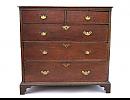Antiques for Sale | Antique Furniture | Antique Fairs | Antiques Listings | Antiques Email Alerts | Websites for Antique Dealers | Contact

Rob Hall Antiques
Tel : 07858 820345
Email : rob@robhallantiques.co.uk
Web : www.robhallantiques.co.uk
Web : www.antiques-atlas.com/rnhantiques/
Private dealer
By appointment only
Oundle, Northants, UK
Open: by appointment, please ring or email.
Early 19th C Tavern Coaching Times Indicator



Description
A very rare wooden time indicator displaying the time of the next passenger and mail coach - the M & P denoting MAIL or PASSENGER. The arabic numerals around the painted dial denote the time up until 4pm - the time of the last coach.In the centre the two brass rings would have held the pole on which the indicator was positioned in a tavern.
Originating in England in the 13th century, the stagecoach as we know it first appeared on England’s roads in the early 16th century. A stagecoach is so called because it travels in segments or "stages" of 10 to 15 miles. At a stage stop, usually a coaching inn, horses would be changed and travelers would have a meal or a drink, or stay overnight.
The first coaches were fairly crude and little better than covered wagons, generally drawn by four horses. Without suspension, these coaches could only travel at around 5 miles an hour on the rutted tracks and unmade roads of the time. During cold or wet weather, travel was often impossible. A writer of 1617 describes the “covered waggons (sic) in which passengers are carried to and fro but this kind of journeying is very tedious, so that only women and people of inferior condition travel in this sort.”
The first stagecoach route started in 1610 and ran from Edinburgh to Leith. Early coach travel was slow in 1673, it took eight days to travel by coach from London to Exeter! However the formation of a stage company in 1706 established a regular coach route between York and London and soon there were regular coach services on many other routes.
Coaching inns sprang up along these routes to service the coaches and their passengers. Many of these inns are still trading today they can be recognised by the archways which allowed the coaches to pass through into the stable yard behind the inn.I
n the 17th and 18th centuries, stagecoaches were often targeted by highwaymen such as Dick Turpin and Claude Duval. Today we have rather a romanticised notion of highwaymen with their cries of ‘Stand and Deliver!’, but in reality these masked men terrorised the roads of England. The punishment for highway robbery was hanging and many highwaymen met their maker at the gallows at Tyburn.
The golden age of the stagecoach was during the Regency period, from 1800 to 1830. The era saw great improvements in the design of the coaches, notably by John Besant in 1792 and 1795. His coach had a greatly improved turning capacity and braking system and a novel feature that prevented the wheels from falling off while the coach was in motion. Besant, with his partner John Vidler, enjoyed a monopoly on the supply of coaches, and a virtual monopoly on their upkeep and servicing for the following few decades.
The development of the railways in the 1830s heralded the end for the stagecoaches and mail coaches. The first rail delivery between Liverpool and Manchester took place on 11 November 1830. By the early 1840s most London-based coaches had been withdrawn from service.
Early 19th century
Measuring 21” wide, 9.5” high
£3,250
DateMid 19th Century :
Early 19th century
Codeas226a321
Price SOLD £3250.00
StatusSold
SellerRob Hall Antiques
Telephone07858 820345Non UK callers :+44 7858 820345 Emailrob@robhallantiques.co.uk
Contact
Send Rob Hall Antiques a message about this item here




